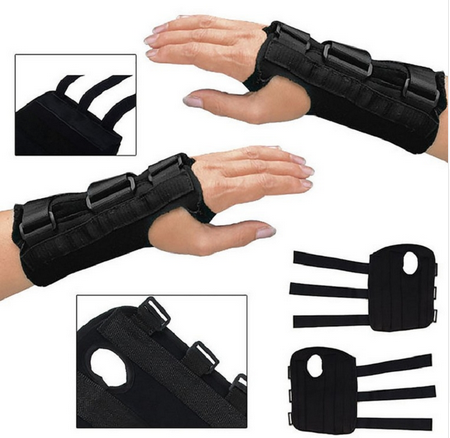Carpal Medical Wrist Support Sprain Forearm Splint Adjustable Breathable Wrist Support Brace Medical
EditDiagnosing Carpal Tunnel Syndrome at Home
 Assess your risk factors for carpal tunnel syndrome. Assessing your risk factors can put you in a better position to understand the symptoms, to recognize the condition and to better treat it. Assess if you have one or more of the following risk factors:[2]
Assess your risk factors for carpal tunnel syndrome. Assessing your risk factors can put you in a better position to understand the symptoms, to recognize the condition and to better treat it. Assess if you have one or more of the following risk factors:[2]- Gender and age: women tend to develop carpal tunnel syndrome more than men and it is most frequently diagnosed between the ages of 30 and 60.
- Occupation: having a job that requires a lot of use of your hands, such as factory or assembly line work, puts you at a greater risk for the syndrome.
- Underlying conditions: those with metabolic disorders, rheumatoid arthritis, menopause, obesity, thyroid disorders, kidney failure, or diabetes have a greater chance at developing the condition.
- Lifestyle factors: smoking, high salt intake, sedentary lifestyle may increase your risk of carpal tunnel syndrome


 Try the Phalen's Test. This is an easy test that can be used in the diagnosis of carpal tunnel syndrome.[5] There are several ways to test this. Try the following:
Try the Phalen's Test. This is an easy test that can be used in the diagnosis of carpal tunnel syndrome.[5] There are several ways to test this. Try the following:- Sit at a table and place your elbows on the table.
- Let your wrist fall to maximal flexion to increase the pressure in the carpal tunnel.
- Hold this position for at least one minute.
- Another way to do the test is to place the backs of both hands together in front of you, pointing fingers down (like an opposite prayer position).
- Any pain and tingling of hands, fingers and/or wrist and numbness in the fingers, specifically, at the height of thumb, forefinger, and a part of the middle finger, are positive results.
 Try the other carpal tunnel tests. Several tests for diagnosing carpal tunnel have been described but the specificity of these tests is questionable. You may still try them:[6]
Try the other carpal tunnel tests. Several tests for diagnosing carpal tunnel have been described but the specificity of these tests is questionable. You may still try them:[6]- The Tinel’s sign is done by tapping the wrist and carpal tunnel with your fingers or a tendon hammer. If it causes tingling in the fingers, it is believed to be a positive test.
- The Tourniquet test is based on temporarily increasing the carpal tunnel pressure by applying a blood pressure cuff to the upper arm or forearm. Inflate the cuff between systolic and diastolic pressure to obstruct venous return from the arm and increasing blood volume in the hand. If this causes symptoms, the test is positive. However, don't perform this test unless you are comfortable using a blood pressure cuff correctly.
- The hand elevation test is done by elevating the hands above the head for two minutes. If this causes symptoms, then the test is positive.
- The Durkan’s carpal compression test relies upon direct pressure applied over the carpal tunnel to increase the pressure. Press the carpal tunnel with your thumb or ask a friend to do this. If this causes symptoms, the test is positive.















No comments:
Post a Comment